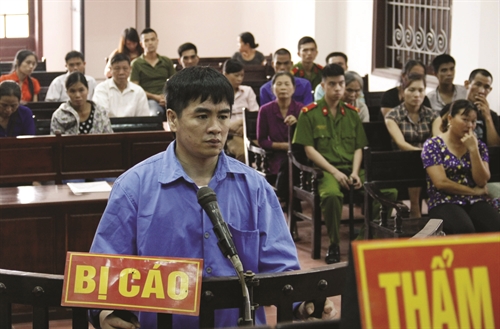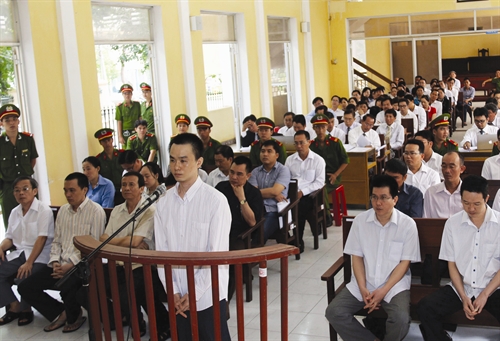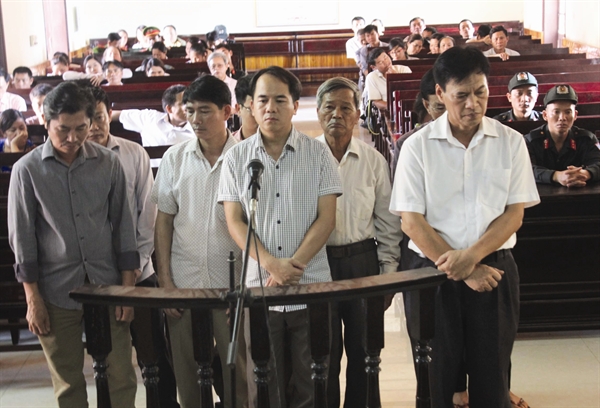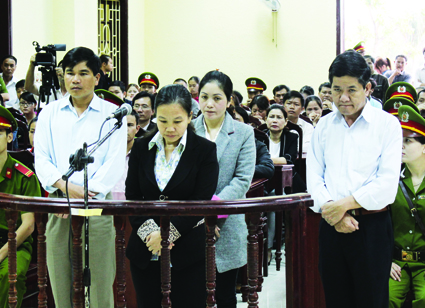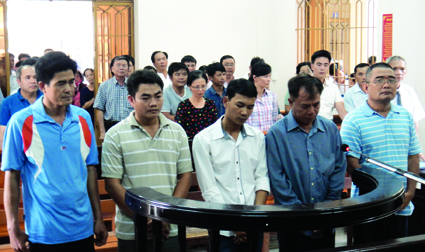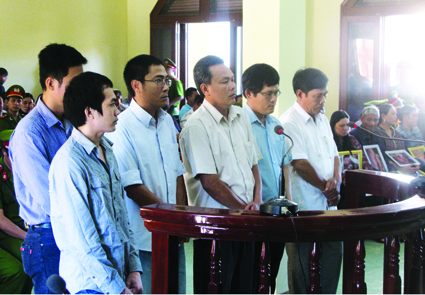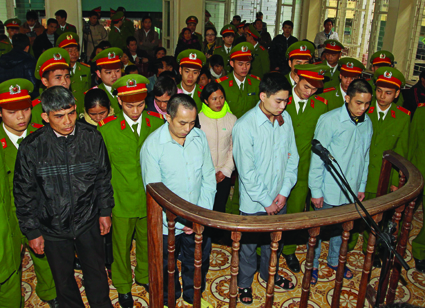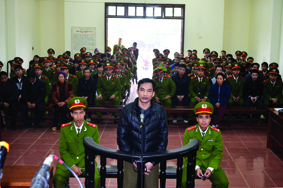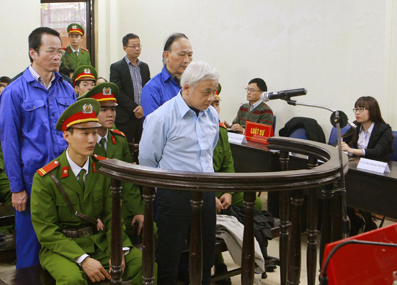Development and application of court precedents in line with the Party’s policies and the State’s laws will contribute to ensuring the uniform application of law, raising quality of trial activities and safeguarding justice, human rights and lawful rights and interests of citizens and organizations in the spirit of the 2013 Constitution.
Truong Hoa Binh
Chief Justice, the Supreme People’s Court
With their internationally recognized significance and value, court precedents, if applied in Vietnam, would help the courts overcome difficulties and problems in their adjudication work and put an end to the overload and lateness in the issuance of documents to implement enacted laws, especially in the context that the people and society have a higher expectation of the quality of court trial, cases and matters falling under court jurisdiction grow in number and complexity, and many provisions of law remain ambiguous or unspecific. Applying court precedents is an effective measure to address inadequacies of law, ensure the uniform application of law in trial and ensure the consistency, transparency and predictability of court judgments. Court precedents can also serve as guidelines for behaviors of involved parties and the community as well.
In the course of carrying out the judicial reform, the Party expressed the viewpoint on development of court precedents in Politburo Resolution No. 48-NQ/TW dated May 24, 2005, on the Strategy for improvement of the legal system through 2020. It assigned the Supreme People’s Court to develop court precedents under Politburo Resolution No. 49-NQ/TW dated June 2, 2005, on the Strategy for judicial reform through 2020.
With a thorough grasp of the Party’s viewpoint on judicial reform, correct perception and high political determination, the Supreme People’s Court has taken the initiative in actively drawing up a plan on development of precedents of people’s courts. In order to have theoretical and practical grounds for drawing up this plan, the Supreme People’s Court has carried out a research into the application of precedents in trial activities of Vietnamese courts. The outcomes of this research have been incorporated in the draft revised Law on Organization of People’s Courts.
On November 24, 2014, the National Assembly passed the Law on Organization of People’s Courts (the Law). According to this Law, the Judicial Council of the Supreme People’s Court has the duty “to select standard cassation trial decisions of the Judicial Council of the Supreme People’s Court and judgments and decisions of various courts which have taken legal effect, develop them into court precedents, and publicize these court precedents for courts to study and apply in trial”. The Law also assigns the Chief Justice of the Supreme People’s Court “to direct the review of adjudicating practices; drafting and issuance of resolutions of the Judicial Council of the Supreme People’s Court in order to ensure the uniform application of law in trial; the review, development and publicization of court precedents.”
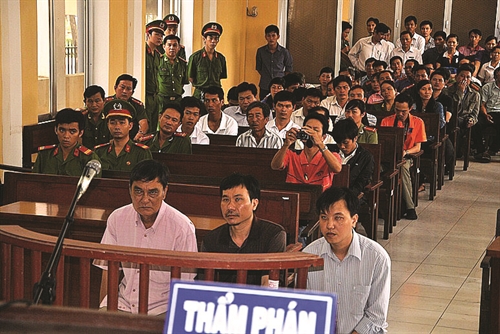 |
| Defendants Pham Van Nui, Nguyen Hoang Quan and Trieu Tuan Hung at the hearing for their crimes of applying corporal punishment and neglecting responsibility causing serious consequences in Soc Trang province __Photo: Trung Hieu /VNA |
To organize the implementation of the Law and effective application of court precedents in trial activities, it is necessary to take the following measures:
Firstly, to create and complete legal bases for the issuance of court precedents:
The procedural law should be added with provisions on legal validity and principles of application and invocation of court precedents in the trial of criminal, civil, marriage and family, business and commercial, labor and administrative cases. The Judicial Council of the Supreme People’s Court should work out a resolution on procedures for issuance and application of court precedents, setting specific criteria for court judgments and decisions to be selected and recognized as court precedents; and procedures for identification and selection of court precedents. This resolution should provide the publicization of legally effective judgments and decisions selected to be developed into court precedents on scientific forums and in the mass media for public comment. The assessment, approval and publicization of court precedents; principles of application of court precedents in trial; and replacement and cancellation of court precedents should also be regulated in such resolution.
Secondly, to prepare and organize the specialized apparatus and personnel to advise and assist the Judicial Council of the Supreme People’s Court in carrying out procedures for selecting, issuing and publicizing court precedents in different fields of trial (criminal, civil, marriage and family, business and commercial, intellectual property, bankruptcy, labor, and administrative precedents). All conditions and facilities for selection and issuance of court precedents should be prepared, including building capacity for the E-Portals of the Supreme People’s Court and the Central Military Court; and developing websites of superior people’s courts, provincial-level people’s courts and district-level people’s courts.
Thirdly, to train judges, assessors and other judicial staff inside and outside the system of people’s courts in writing judgments, editing court precedents, and studying, analyzing and applying court precedents.
Roadmap for developing and applying court precedents
After studying relevant provisions of the 2013 Constitution, the Law, as well as regulations on court precedents of some other countries, we have mapped out the following steps in developing court precedents:
Setting criteria for selection of court precedents
According to Point c, Clause 2, Article 22 of the Law, and stemming from the purpose and requirements of the issuance of court precedents, to be selected as a court precedent, a court judgment or decision must satisfy the following criteria:
(i) Being a cassation trial decision of the Judicial Council of the Supreme People’s Court, a superior people’s court or the Central Military Court, or a legally effective judgment or decision of another court (superior people’s court, provincial-level or district-level people’s court) on a specific case or matter;
(ii) Containing arguments to clarify one or several ambiguous provision(s) of law which may be understood in different ways, or framework regulations; analyzing and explaining legal matters or events and pointing out principles and guidelines or legal norms for settling these matters; and being advocated by public-elected deputies, specialists, scientists, practitioners, and the people;
(iii) Being of standard quality and precedential value in guiding trial and ensuring the uniform application of law.
Establishing procedures for issuing precedents
In light of the provisions of the Law regarding the jurisdiction of courts at each level and the duties and powers of the Judicial Council of the Supreme People’s Court, and the criteria set for court precedents, the issuance of precedents should be carried out as follows:
(i) Reviewing, identifying and proposing court precedents
- Based on the criteria for selection of court precedents, chief justices of provincial-level people’s courts, military courts of military zones and equivalent courts would organize the review, assessment and identification of legally effective judgments and decisions of their courts and courts within their territorial jurisdiction, and request the judicial committees of their courts to consider and assess such judgments and decisions.
If the judgments and decisions satisfy the criteria for being selected as court precedents, the chief justices would send their proposals for selection of court precedents together with these judgments and decisions and assessment reports of the judicial committees of their courts to the Supreme People’s Court.
- Based on the same criteria, chief justices of superior people’s courts and the Chief Justice of the Central Military Court would organize the review, assessment and identification of cassation trial decisions and legally effective judgments and decisions of their courts, and request the judicial committees of their courts to consider and assess such judgments and decisions.
If these judgments and decisions are eligible for being selected as court precedents, the chief justices would send their proposals for selection of court precedents together with these judgments and decisions and assessment reports of the judicial committees of their courts to the Supreme People’s Court.
- Using the same criteria, the directors of the supervision and inspection departments of the Supreme People’s Court would organize the review, assessment and identification of cassation trial decisions of the Judicial Council of the Supreme People’s Court and legally effective judgments and decisions of other courts; send their proposals for selection of court precedents together with the qualified cassation trial decisions of the Judicial Council of the Supreme People’s Court and legally effective judgments and decisions of other courts to the Legal Affairs and Science Management Department of the Supreme People’s Court. Their proposals should specify legal matters for which the proposed judgments and decisions can serve as precedents. Through scientific forums or the publicization of court judgments and decisions, the public can also propose court judgments and decisions that are eligible for being selected as court precedents to the Supreme People’s Court.
- The review, identification and proposal of court precedents should be conducted by the courts once every six months.
(ii) Collecting comments on judgments and decisions proposed to be selected as court precedents
Right after receiving the judgments and decisions proposed to be selected as court precedents, the Legal Affairs and Science Management Department of the Supreme People’s Court would publish them on the Toa an nhan dan (the People’s Court) journal, the E-Portal of the Supreme People’s Court and in other mass media for public comment for two months. It can also hold seminars to collect comments from National Assembly deputies, specialists, scientists, practitioners and concerned agencies and organizations.
(iii) Selecting and recognizing court precedents
Within one month after the expiration of the two-month period for publicizing the judgments and decisions to be selected as court precedents, the Legal Affairs and Science Management Department of the Supreme People’s Court and other departments of the Supreme People’s Court would summarize the collected comments, organize the study, assessment and selection of the judgments and decisions qualified to be recognized as court precedents and submit them to the Chief Justice of the Supreme People’s Court. A council would be established by the Chief Justice of the Supreme People’s Court to consider whether these judgments and decisions are eligible for being selected as court precedents. Those judgments and decisions selected by this council would be then brought up for discussion and voting at a plenary meeting of the Judicial Council of the Supreme People’s Court. Finally, the Chief Justice of the Supreme People’s Court would issue decisions on recognition of court precedents.
(iv) Publishing court precedents
The judgments and decisions which are recognized as court precedents would be edited, pointing out legal issues which have the precedential value in guiding trial and uniform application of law, before they are published in the jurisprudence and justice journals, mass media and E-Portal of the Supreme People’s Court. A collection of court precedents would be published biannually and sent to the courts for uniform application.
Application of court precedents in trial
Under Point c, Clause 2, Article 22 of the Law, judges and assessors are obliged to study and apply court precedents in trial. Once a court precedent is applied to settling a similar case or matter, the similar characteristics and circumstances indicated in the court precedent, characteristics and circumstances of the case or matter being settled, and the legal issue settled by the court precedent should be presented, analyzed and clarified in the court judgment or decision. Judges and assessors who refuse to apply court precedents would be required to justify their refusal. This principle should be incorporated in the draft revised Criminal Procedure Code, Civil Procedure Code and Administrative Procedure Law to be submitted to the National Assembly in the coming time.
Cancellation and replacement of court precedents
In case a court precedent becomes inappropriate due to a change in the law or a new development in the practical situation, the Judicial Council of the Supreme People’s Court would be responsible for considering and approving the cancellation or replacement of such court precedent.
The cancellation or replacement of court precedents would be published on the E-Portal of the Supreme People’s Court, Toa an nhan dan (People’s Court) journal and other jurisprudence and justice journals, and notified to the courts.-
